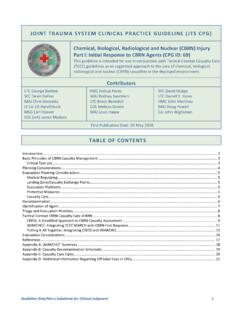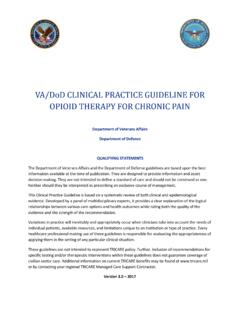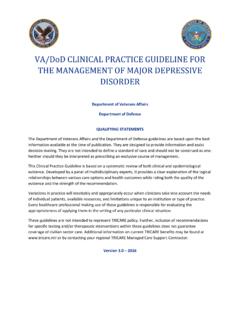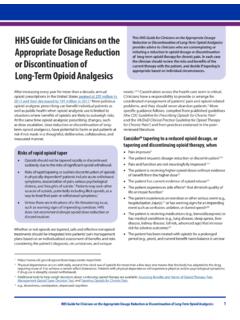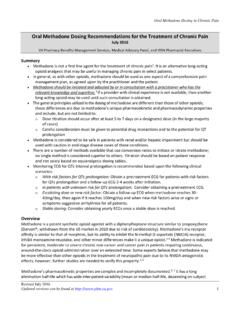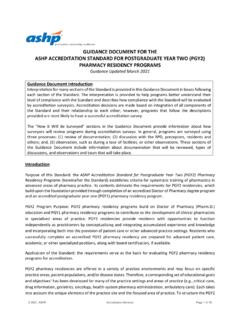Transcription of Documentation Requirements for Combat Casualty Care …
1 JOINT TRAUMA SYSTEM clinical PRACTICE GUIDELINE (JTS CPG) Documentation Requirements for Combat Casualty Care (CPG ID: 11) This CPG stresses the need for complete and accurate trauma Documentation of an event, including evacuation on all trauma patients from point of injury to Role 2/3. Contributors LCDR (ret) Domenique Selby, BSN, RN, CEN LCDR (ret) Erin Eickhoff, DNP, RN, PHN, NP-BC MSG Michael Remley, USA, NRP, SO-ATP COL (Ret) Lawrence Crozier, MSN, RN, CENP COL (ret) Elizabeth Mann-Salinas, PhD, RN 1SG Branden Coughlin, USA, NRP, FP-C LTC (Ret.) Joseph Winter, MSN, RN Ms. Cynthia R. Kurkowski, B. J. COL Stacy A. Shackelford, USAF, MC Original Publication: 01 Jun 2008 Publication Date: 18 Sep 2020 Supersedes CPG: Battle versus Non-Battle Injury Documentation Resuscitation Record, 05 Dec 2013 Supersedes CPG: Use of Electronic clinical Documentation in the CENTCOM AOR, 5 Jun 2012 TABLE OF CONTENTS Background.
2 2 Patient Care Documentation guidelines .. 3 Prehospital Documentation .. 3 Transport Documentation .. 3 Role 2 & Role 3 Documentation .. 3 Theater Medical Data Store & Trauma Logs .. 4 DoD & JTS Forms .. 5 Primary Required Forms .. 5 Prolonged Field Care .. 5 Blood Transfusion Forms .. 5 Burn CPG Forms .. 6 REBOA Form .. 6 Spinal Injury Cervical & Thoracolumbar Forms .. 6 Brain Injury Form .. 6 Military Working Dog Forms .. 6 Expectations: Form Completion .. 6 PI Monitoring .. 7 Population of Interest .. 7 Intent (Expected Outcomes) .. 7 Performance/Adherence Metrics .. 8 Data Source .. 8 System Reporting & Frequency .. 8 Responsibilities .. 8 Documentation Requirements for Combat Casualty Care CPG ID: 11 Guideline Only/Not a Substitute for clinical Judgment 2 BACKGROUND Trauma Documentation within the military trauma system supports optimal patient care and performance improvement (PI).
3 Documentation has continuously increased since the Joint Theater Trauma Registry (JTTR), now known as the DoD Trauma Registry (DoDTR), was initiated in 2004. DoDTR data acquisition and processing has improved greatly, due in part to standardization of the Resuscitation Record, Tactical Combat Casualty Card (TCCC), and Tactical Evacuation (TACEVAC) Patient Care Record (PCR) as well as standardized prehospital and en route care after action reports (AARs) and PI reviews. The dedicated efforts by Service, Combatant Command, and JTS personnel to capture these documents following patient care promotes inclusion within the medical record and transfer to the DoDTR. During massive Casualty events, Documentation reduces chaos and improves patient tracking. Accurate Documentation improves: Trauma readiness Treatments Outcomes Standard of care development The evaluation of rescue systems Casualty response processes Adherence to approved treatment guidelines It is critical that all levels of the trauma system, including point of injury, en route, austere and facility-based roles of care, ensure that their Casualty Documentation , after action reports, and PI forms reach the JTS for incorporation into the DoDTR.
4 Combat Casualty care Documentation incorporates information from numerous sources such as nursing flow sheets, monitors, Medical Evacuation (MEDEVAC) patient care records, point of care laboratory devices, and anesthesia records. Documentation of history, physical examination, interventions and decision-making not only optimizes ongoing care of the Casualty , but also contributes to improved care of future casualties when incorporated into the DoDTR. For prehospital providers and small teams who operate in a kinetic and austere setting, it may not be possible to document and provide care simultaneously, and providing optimal care always takes priority. In such cases, completion of the Documentation and AAR as soon as possible after the event with transmission to JTS, preferably within 72 hours of injury, is necessary and meets the intent of this CPG. Documentation of trauma care provided to all patients treated within the military system is relevant, and all categories of patients treated are incorporated into the DoDTR.
5 It is critical that all roles of care utilize the same name for an individual Casualty according to the theater standard pseudo name policy to ensure quality data. This requires communication and follow up, particularly for reports submitted after evacuation from that role of care. While technology is being implemented to facilitate electronic Documentation by the initial roles of care, much of the initial trauma Documentation is still hand-written and must be scanned in to the Theater Medical Data Store (TMDS) order to incorporate into the records. As there is no global solution to this challenge, each treating location must identify a means to transfer hand-written records to a location where they can be scanned. Documentation Requirements for Combat Casualty Care CPG ID: 11 Guideline Only/Not a Substitute for clinical Judgment 3 PATIENT CARE Documentation guidelines PREHOSPITAL Documentation The DD 1380, TCCC Card, is initiated by point of injury non-medical or medical personnel once all major life threats have been addressed in accordance with TCCC guidelines .
6 Each Service member should carry a DD 1380 with their personal identifiers pre-positioned and stored within their first aid kit. The purpose of the DD 1380 is to provide prehospital providers a standardized document to record all TCCC interventions administered at the point of injury and facilitate handoff to the next role of care. It should accompany the Casualty during initial evacuation and be accounted for upon arrival at the first surgery capability. The TCCC card will be scanned and uploaded into TMDS utilizing the Casualty name established by the first surgical team. TCCC AAR documents should be submitted for each Casualty to the JTS via the AAR submission email link on the JTS Forms and After Action Report Submission web page within 72 hours post injury or as soon as possible after mission completion. AARs must be submitted using the actual name or pseudo name for all patients subsequently treated by surgical teams; this requires communication and follow up between the prehospital and surgical teams.
7 A secure email option is provided for convenience, however AARs submitted to the DoDTR should include only content up to the For Official Use Only level. The prehospital PI form should be used to review care and Documentation and should be completed by the Unit Medical Officer or the Senior Enlisted Medical Advisor and submitted along with the AAR using the previous JTS web link. Units requesting a unit-specific PI report can contact JTS at ( unit must be identified on the AARs or a patient log provided). When prehospital care transitions to PFC, Documentation should transition from the TCCC card to the Prolonged Field Care (PFC) Worksheet. As a follow-on to the TCCC card, the PFC Worksheet is used to document trends over time and is the most useful tool to recognize important clinical changes in complex casualties such as decompensation, response to resuscitation, development of complications, effectiveness of medications, etc.
8 TRANSPORT Documentation The TACEVAC Evacuation Patient Care Record (DA 4700) and AAR should be initiated on all patients transported via ground or rotary-wing platform. This form may be initiated during transport, but is ideally suited to be completed electronically after mission completion. Forms should be reviewed by local medical directors to aid in unit level quality assurance efforts. These forms should be completed within 72 hours of a patient care event, and may be completed digitally or by hand. (This form is not intended to supersede the AF 3899 during patient transport by Air Force air evacuation assets). ROLE 2 & ROLE 3 Documentation A Resuscitation Record (DD 3019) and any required supplemental Documentation (JTS Burn Flow Sheet, C-Spine Clearance Form, etc.) should be initiated on ALL patients anticipated to be admitted in a Role 2 setting or higher role of care (including those patients who are transferred for admission to a host nation facility).
9 This includes patients with battle/non-battle injury who are coalition forces, local nationals, contractors, and civilians. It is the intent of this guideline that the broadest definition of trauma be used. This should include the majority of patients with single or multi-system injury seen in the emergency department who may require admission or who are admitted directly to the hospital, and is to be used as the primary method of initial Documentation . Documentation Requirements for Combat Casualty Care CPG ID: 11 Guideline Only/Not a Substitute for clinical Judgment 4 In situations when there are not enough team members to allocate one individual to Documentation , such as during mass Casualty events or austere surgical team treatments, the MASCAL/Austere Team Record may be utilized (DD Form # pending). The Resuscitation Record (DD 3019) should be completed on all patients evaluated and admitted within the first 72 hours following injury, including but not limited to the following injury causes: Building Collapse Bullet/Gunshot Wound/Firearm Burn Explosively Formed Projectile/Penetrator Fall Fire/Flame Improvised Explosive Device Inhalation Injury Mine Mortar/Rocket/Artillery Shell Multi-Frag Motor Vehicle Crash Sports Unexploded Ordnance All trauma admissions to any/all Role 2 or 3 facilities in the continuum All care delivered by each resuscitation and surgical capability will be documented for that role of care on the appropriate record and signed by the physician (preferably), nurse, or team member documenting before transport to next role of care.
10 In situations where evacuation occurs before Documentation can be completed, the record should be completed as soon as possible and transmitted electronically to the next role of care as well as to JTS. It is important that all documents are annotated with provider names with both a time and date of injury as well as arrival to surgical capability in order to ensure timeline accuracy within the registry. If time of injury is an estimate, note that in the Documentation . THEATER MEDICAL DATA STORE & TRAUMA LOGS The TMDS provides web-based access to Service member medical information entered at deployed medical treatment facilities using AHLTA-Theater (Armed Forces Health Longitudinal Technology Application), Shipboard Automated Medical System (SAMS), Global Expeditionary Medical System (GEMS), Cach TC2, and TRANSCOM Regulating and Command & Control Evacuation System (TRAC2ES).

